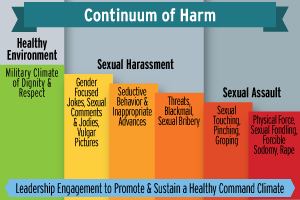Skip subpage navigation
By Holly N. O'Reilly, Ph.D.
April 6, 2020
 SAPRO graphic
SAPRO graphic
In April the Department of Defense observes Sexual Assault Awareness and Prevention Month and the theme this year is "Protecting our People Protects our Mission." You can find 2020 SAAPM campaign information and resources from the DOD Sexual Assault Prevention and Response Office.
SAPRO has extensively researched sexual assault and its risk factors in order to inform DOD prevention and response efforts. A helpful perspective from this research is viewing sexual assault as part of a much broader continuum of harm impacting military culture. A recent Government Accountability Office report also noted that addressing behaviors across the continuum of harm is key to DOD prevention efforts. Accordingly, PHCoE is joining the call to promote awareness and prevention of sexual assault and harassment in the military with a series of blogs in April providing information and available resources. This blog will provide some basic information on the continuum of harm to help inform clinicians.
What is the continuum of harm?
The continuum of harm refers to a range of :inappropriate actions, such as sexist jokes, hazing, and cyber bullying that are used before or after the assault and or supports an environment which tolerates these actions" (DOD 2016 Workplace and Gender Relations Survey of Active Duty Members). The most subtle forms of inappropriate behavior on the continuum include innuendo and jokes based on gender or sexuality. To paraphrase Department of Defense Instruction 1020.03 Harassment Prevention and Response in the Armed Forces, sexual harassment may include unwelcome sexual advances, repeated comments of a sexual nature and/or requests for sexual favors which make an individual uncomfortable and imply that rejection of this behavior will lead to negative work conditions or career impact. For example, one of my former patients reported that his immediate supervisor made numerous sexual comments toward him and when he stated that he was not interested, he was assigned undesirable duty hours and unpleasant work tasks. The most extreme behaviors on the continuum of harm include use of physical force and other types of sexual assault.
Why is it important?
The continuum of harm is a destructive pattern of behavior with numerous negative consequences:
- Centers for Disease Control and Prevention research found that individuals who engage in hazing and bullying as adolescents are likely to engage in sexual harassment later in life. Thus, it is important to intervene before these behaviors escalate.
- Elements of the continuum of harm are indicators of a potentially unhealthy command climate and are targeted as risk factors in DOD prevention efforts.
- Disrespectful and destructive behaviors on the continuum are harmful, decrease operational readiness, and are inconsistent with military core values.
- An environment that tolerates inappropriate behaviors and sexual violence erodes trust and unit cohesion.
What can you do?
- Get smart on the continuum of harm using the resources below.
- Help service members recognize and identify behaviors along the continuum. Once identified, help them connect to resources and advocacy.
- Attend and, when appropriate, contribute your expertise to your unit or service efforts to address these problematic behaviors.
- Set the example for others by engaging in helpful bystander intervention strategies. For example, speak up (and encourage colleagues and patients to speak up) when it's appropriate to call out disrespectful behavior. For example, "We don't use that kind of language here."
Resources for Providers
April Sexual Assault Awareness and Prevention Month is a call to action to provide a culture within the DOD which does not tolerate, ignore or condone behaviors along the continuum of harm. Please share in the comments below about your efforts to address behaviors on the continuum of harm and resources to increase understanding about sexual assault and harassment.
Dr. O'Reilly is a clinical psychologist and sexual assault/sexual harassment SME at the Psychological Health Center of Excellence. She specializes in the consequences of psychological trauma and women's mental health.
You are leaving Health.mil
The appearance of hyperlinks does not constitute endorsement by the Department of Defense of non-U.S. Government sites or the information, products, or services contained therein. Although the Defense Health Agency may or may not use these sites as additional distribution channels for Department of Defense information, it does not exercise editorial control over all of the information that you may find at these locations. Such links are provided consistent with the stated purpose of this website.
You are leaving Health.mil
View the external links disclaimer.
Last Updated: May 23, 2024